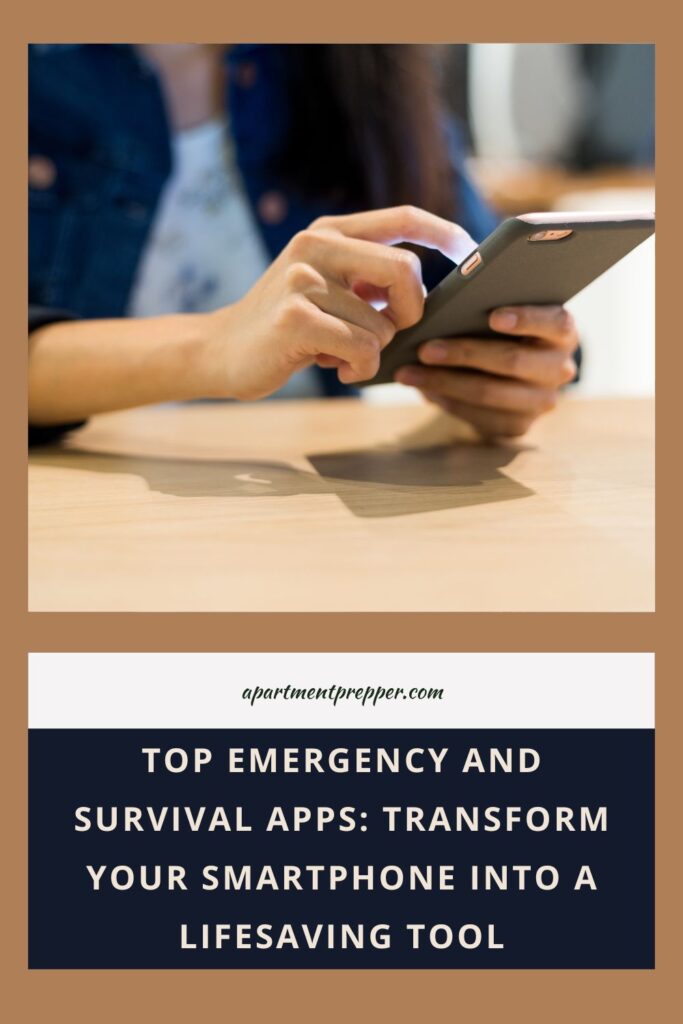Written by Bernie Carr
In an emergency, every second counts, and having the right information or tool at your fingertips can make a huge difference. With the rise of smartphones, there are now many apps designed to help you prepare for, navigate, and survive all kinds of emergencies. From weather alerts to first aid guides and navigation, these apps transform your phone into a valuable tool for survival. Here, we explore the best and safest emergency and survival apps available and how to effectively use them in a crisis.
1. Weather Apps
Weather-related emergencies, such as hurricanes, floods, tornadoes, or wildfires, are unpredictable and often life-threatening. Having real-time weather updates on your smartphone is essential for staying ahead of the storm. Here are some of the top weather apps to consider:
- The Weather Channel App
One of the most widely used weather apps, The Weather Channel offers local and national weather forecasts, severe weather alerts, radar information, and hurricane tracking. It provides real-time updates on developing weather systems, helping you stay prepared for sudden changes.
How to use: Enable push notifications for severe weather alerts, and check the radar for real-time storm tracking. - AccuWeather
AccuWeather is known for its minute-by-minute weather forecasts and real-time severe weather warnings. The app offers highly accurate predictions and features such as storm tracking and alerts for extreme weather events like tornadoes and flash floods.
How to use: Customize your location settings to receive weather alerts specific to your area and download offline weather data in case of network outages. - Meteor Another weather app that I tried recently is called Meteor. I customized it to use location services and it gives me current weather wherever I am, even when I’m driving or on a road trip. I found it easy to use. How to use: Allow the app to access your location for accurate forecasts, and provide weather alerts wherever you are.
2. Safety & Security Apps
Your personal safety during an emergency can be just as important as having the right supplies. Safety and security apps are designed to provide you with emergency alerts and allow you to notify loved ones of your location and safety status.
- Red Panic Button
The Red Panic Button app is designed for quick, one-tap emergency alerts. By pressing the panic button, the app will send an SOS message to your designated emergency contacts, sharing your GPS location. This app is useful in a variety of emergency situations, from medical crises to personal safety threats.
How to use: Program your emergency contacts into the app and ensure the location-sharing feature is enabled for quick access. - bSafe
bSafe is another excellent personal safety app. It allows you to set up emergency contacts who will receive live location updates, audio, and video recordings when you trigger the app’s SOS function. It also has a “Follow Me” feature that enables your contacts to monitor your journey home or to safety in real-time.
How to use: Activate the “Follow Me” feature if you’re traveling alone in unfamiliar or dangerous areas, and test the SOS function to familiarize yourself with its use in an emergency.
3. First Aid Apps
Knowing how to administer first aid can be critical in emergencies. These apps guide you through basic medical procedures, from treating wounds to administering CPR, ensuring you can act quickly before professional help arrives.
- First Aid by American Red Cross
This app offers step-by-step instructions for common medical emergencies, such as burns, cuts, fractures, and heart attacks. It provides video tutorials and interactive quizzes to help you learn first aid skills in advance, but also offers instant guidance in an actual crisis.
How to use: Familiarize yourself with the app’s main categories and enable offline access to first aid guides in case of loss of internet access. - St. John Ambulance First Aid
Similar to the Red Cross app, St. John Ambulance offers a wide range of first aid instructions for common and serious medical issues. It includes information on dealing with strokes, heart attacks, and diabetic emergencies, making it a valuable resource for those with chronic conditions.
How to use: Search for specific first aid topics in the app based on symptoms or conditions, and bookmark essential guides for quick access.
4. Medical Information Apps
Having your medical information easily accessible during an emergency is crucial, especially if you’re unable to communicate with first responders. These apps store critical health information and ensure first responders have access to it.
- MyID – Medical ID Profile
MyID stores important medical information such as allergies, medications, blood type, and emergency contacts. First responders can access this data even when your phone is locked, ensuring they know your medical history and any relevant conditions.
How to use: Input your medical details and emergency contacts. Ensure the app is visible on your lock screen for quick access during emergencies. - ICE (In Case of Emergency)
The ICE app serves a similar function by storing your medical details and emergency contacts. It allows first responders to see your health information without unlocking your phone, making it a convenient tool during medical emergencies.
How to use: Regularly update your medical information in the app and ensure your emergency contacts are current.
5. Navigation Apps
Whether you need to evacuate due to a natural disaster or find your way through unfamiliar terrain, navigation apps are essential for getting to safety.
- Google Maps
Google Maps is not only useful for everyday navigation, but it’s also a powerful tool in emergencies. You can download offline maps, which is particularly valuable if you lose internet or cell service. The app also provides real-time updates on traffic, road closures, and alternative routes.
How to use: Download offline maps for areas you frequent, and use the app’s traffic feature to find safe evacuation routes during emergencies. - Gaia GPS
Gaia GPS is a top choice for those who may find themselves in off-grid situations. It offers downloadable topographic maps and advanced GPS tracking even when you’re out of cell range. Whether you’re camping, hiking, or in a rural area, this app ensures you always know your location.
How to use: Download maps for the areas you plan to visit or could be evacuated to, and practice using the app’s offline GPS features before a crisis occurs.
6. Communications Apps
In an emergency, staying in touch with family, friends, and emergency services is vital. These communication apps allow you to send messages or alerts even when traditional phone networks are down.
- Zello
Zello turns your phone into a push-to-talk walkie-talkie, allowing you to communicate with others in real-time. The app works over Wi-Fi and cellular data but also has an offline mode that uses radio waves to connect with others nearby. It’s a great tool for coordinating with family or friends during a disaster.
How to use: Join a local emergency preparedness group on Zello to stay connected during a crisis, and practice using the walkie-talkie feature. - Bridgefy
Bridgefy enables you to send text messages even without an internet connection by using Bluetooth to connect with others within a short distance. It’s an excellent backup communication tool when cellular networks are overloaded or down.
How to use: Ensure the app is set to work in offline mode, and add contacts in advance so you can reach them during an emergency.
7. Government and Emergency Alert Systems
Government alerts provide real-time updates on disasters, severe weather, and other hazards in your area. These apps keep you informed of any critical developments so you can act quickly.
- FEMA App
The FEMA app provides timely alerts about natural disasters, safety tips, and shelter locations. It’s one of the best government resources for staying informed during a crisis.
How to use: Customize the app to receive alerts based on your location, and regularly check for updates on evacuation routes or emergency contacts. - Wireless Emergency Alerts (WEA)
Many smartphones come with WEA automatically enabled, allowing you to receive emergency alerts for severe weather, AMBER alerts, and public safety warnings. Ensure this feature is active on your phone so you don’t miss any critical information.
How to use: Go to your phone settings to confirm that WEA is turned on, and select the types of alerts you want to receive.
How to Utilize These Apps for Emergencies
- Set Up Notifications: Most apps offer push notifications for real-time alerts. Make sure notifications are turned on for the most critical apps, especially weather and government alert systems.
- Download Offline Content: Many of these apps allow you to download maps, medical guides, and other resources for offline use. This is crucial in emergencies when network access may be limited.
- Familiarize Yourself with the Apps: Before an emergency occurs, spend time learning how each app works. Practice using the navigation and communication tools so you’ll be ready if a crisis arises.
- Update Your Information Regularly: Ensure that your medical and emergency contact details are up to date in apps that store this information.
By installing and using these apps, you’ll be better equipped to handle emergencies, whether it’s a weather-related disaster, a medical issue, or a personal safety threat. The right apps can provide real-time information, help you stay connected, and guide you through critical decisions when seconds matter most.
We are an affiliate of Amazon.com, which means we received a small commission if you click through one of our Amazon links when you shop, at totally no cost to you. This helps keep the lights on at the blog. Thanks!
About the author
Bernie Carr is the founder of Apartment Prepper. She has written several books including the best-selling Prepper’s Pocket Guide, Jake and Miller’s Big Adventure, The Penny-Pinching Prepper and How to Prepare for Most Emergencies on a $50 a Month Budget. Bernie’s latest e-book, FRUGAL DIY has just been released on Amazon. Her work appears in sites such as the Allstate Blog and Clark.com, as well as print magazines such as Backwoods Survival Guide and Prepper Survival Guide. She has been featured in national publications such as Fox Business and Popular Mechanics. Learn more about Bernie here.
FB: https://www.facebook.com/apartmentprepper
Instagram: https://www.instagram.com/apartmentpreppers/
Twitter: https://twitter.com/AptPrepper
YouTube: https://www.youtube.com/channel/UC7vOtdbo-wiBeBxD6puCr1Q
Patreon: https://patreon.com/apartmentprepper
Pinterest: https://www.pinterest.com/aptprepper/
Today’s societal climate not supportive of prepping. With your help, we can keep bringing you content that is often suppressed. Help keep Apartment Prepper alive.
Join me on Patreon for ad-free content.

Or Help out via Paypal



